Striking differences
Jon Boys looks at the occupations that are striking and analyses the different factors at play, such as pay, qualifications and hours worked.
Jon Boys looks at the occupations that are striking and analyses the different factors at play, such as pay, qualifications and hours worked.
I have worked on both sides of the negotiating table, first for an employers’ association and then for a trade union. I know the insider tricks. Trade unions like to use RPI inflation because it makes it look like pay has fallen further than CPI inflation. Employer’s like to pick a base year that maximises pay growth (2000 makes it look better than 2010 for example). The truth lies somewhere in the middle of course.
Much has been written on pay and I don’t want it to be the focus of this blog. There is no apolitical way to analyse this data. The best someone can do is be transparent about their sources and methods.
Across the board, pay has been squeezed for these occupations.
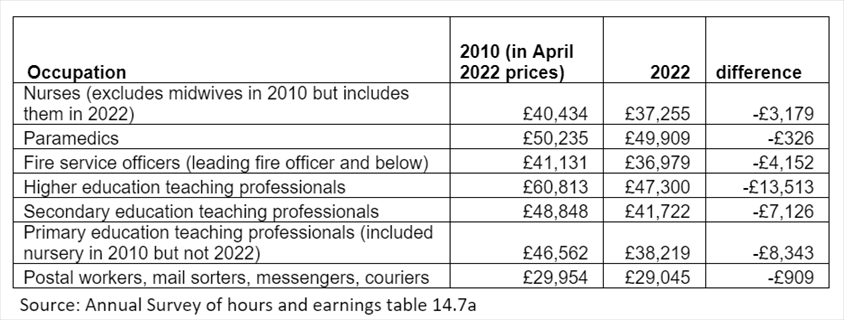
And this pay squeeze continues today. Pay in the public sector (which covers most of these striking occupations) is currently growing at 3.3% while prices are growing at 10.5%. Perhaps more importantly private sector pay is growing over twice as much at 7.2%. For the last few decades public sector pay has been higher than private sector but this changed in about July 2021 and the gap has now grown to £1,356 a year difference.
The labour force survey asks whether people are looking for a new or additional job. The results may surprise you. Nurses and teachers appear to be less likely to look for a new job than workers in general and even those looking are likely to stay in the same occupation. Perhaps people are locked into these occupations due to path-dependent investment in training (though I have met many ex-teachers who work in policy). Without the ability to easily transfer to other career paths, these workers have a higher stake in improving their current occupation.
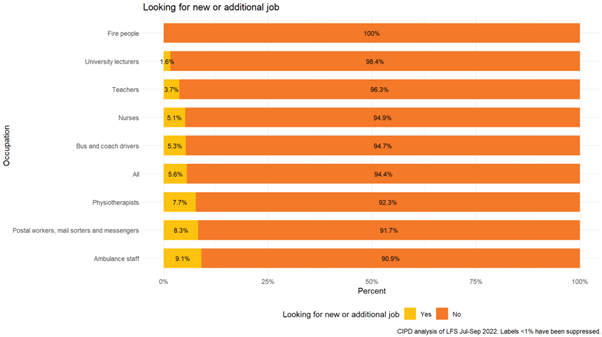
We all have different preferences for the hours we work, and so I have looked directly at people’s desired hours. Many striking occupations would like to reduce their working hours more than the average worker. 40% of teachers would like to work fewer hours.
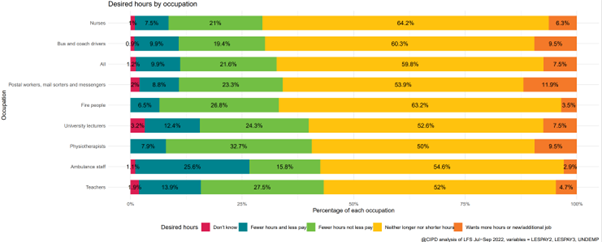
A cynic might say that I’m just trying to be topical, but I think there is something in this. Striking workers generally have very low levels of home working. I have used ‘All workers’ as a comparator but for many of these workers, a more accurate comparator group is other highly qualified skilled professionals, i.e. the alternative career paths these people might take. As the CIPD’s new labour market economist James Cockett shows in his CIPD voice article this month, 35% of professionals mainly work from home (with hybrid an even higher number). Nick Bloom a leading academic on working from home suggests that employees value hybrid working as much as a 10% pay rise. This makes these jobs more attractive (at zero cost to the employer) and jobs without home working relatively less attractive. Put another way, if all nurses were able to work hybrid they may be asking for 9% instead of 19%.
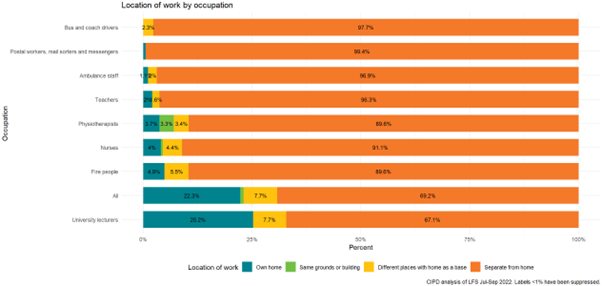
Striking occupations tend to be a highly qualified group with some notable exceptions. This means they have invested a lot of money (tuition and foregone earnings from study) and expect a reasonable return, especially when weighed against alternative career paths.
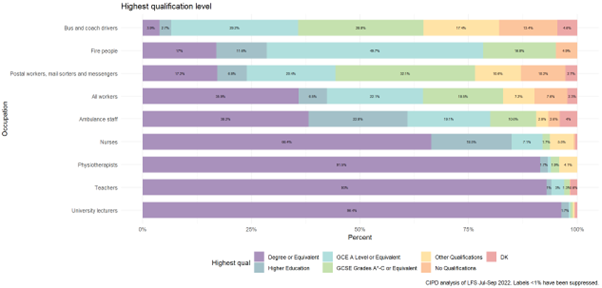
Striking occupations tend to be in the public sector. Their pay has been squeezed and is currently being squeezed more than their private-sector peers. These occupations tend to have low levels of home working which is highly valued by employees. These occupations tend to require high levels of qualifications from which many would reasonably assume a good return. In the current labour market, unemployment is low and people are in demand meaning workers have more bargaining power. Inflation is incredibly high and meaning that any gains to pay could soon be wiped out by rising prices. As inflation goes down and unemployment begins in rise (as most forecasts suggest it will), some of this pressure on wages may ease.
The debate can focus on the pay demands but there are other factors at play. Clearly, some occupations feel their hours are too long. Most striking occupations lack the flexibility of home working and so other flexibility might be needed to compensate. Importantly there are some big differences between these various striking occupations. A better understanding of each of these workforces will lead to better solutions.
Notes
I will inevitably upset both sides of the debate with my numbers so here is a disclaimer on the pay data used. Every few years the system for categorising occupations is changed which makes comparisons across time difficult. In 2010 the category nurses excluded midwives for example. As I’m using summary data tables I can’t recombine the occupations easily. The FT were a bit more squeamish about this than me in a recent article where they used 2011-2020 as a range because this used the same coding system (at the obvious expense of a strange date range). Median pay could change as a result of a change in the composition of the workforce, for example, if more junior people entered and more expensive senior people left. These are relatively rough numbers that conservatively make the point that pay in these occupations has been squeezed.
The labour force survey can give quite small samples for some occupations. Anyone working in this field might consider applying for secure access to the APS as the publicly available APS does not contain a four-digit SOC variable. This would enable the same analysis with a larger sample (I have found that asking the ONS politely also sometimes works).
Base sizes of each occupation in LFS
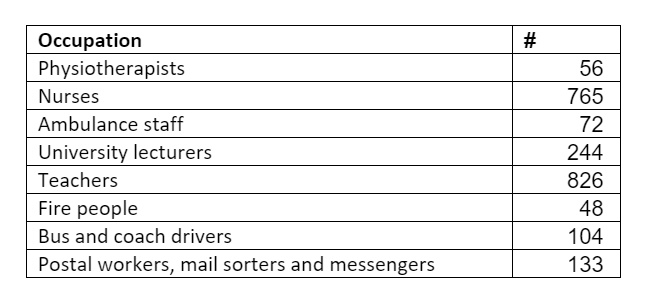
Browse our A–Z catalogue of information, guidance and resources covering all aspects of people practice.
Discover our practice guidance and recommendations to tackle bullying and harassment in the workplace.

Jon joined the CIPD in January 2019 as an Economist. He is an experienced labour market analyst with expertise in pay and conditions, education and skills, and productivity.
Jon primarily uses quantitative techniques to uncover insights in labour market data, both publicly available and generated through in house surveying. Jon regularly contributes commentary and analysis of economic issues on the world of work to online, print and TV media. Recent work includes the creation of an international ranking of work quality, analysis of firm level gender pay gap reporting data, and an ongoing programme of work looking at the changing age profile of the UK workforce.

Understand what employee relations means as a concept and what it means to employers

Ben Willmott explores the new Labour Government strategies to enhance skills and employment to boost economic growth

Dedicated analysis of job quality and its impact on working lives in Scotland

The CIPD Good Work Index provides an annual snapshot of job quality in the UK, giving insight to drive improvement to working lives

Monthly round-up of changes in employment law in the UK

Research on how an employee's socioeconomic background or class affects their development opportunities and how to maximise social mobility in the workplace

We look at the main focus areas and share practical examples from organisations who are optimising their HR operating model

Ben Willmott explores the new Labour Government strategies to enhance skills and employment to boost economic growth